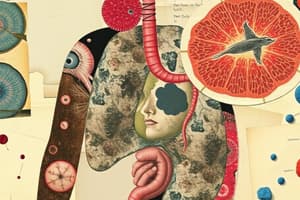Podcast
Questions and Answers
What is the basic unit of structure and function in living things?
What is the basic unit of structure and function in living things?
- Tissue
- Organ
- Organ system
- Cell (correct)
Which type of tissue lines the interior and exterior body surfaces?
Which type of tissue lines the interior and exterior body surfaces?
- Muscle tissue
- Nervous tissue
- Epithelial tissue (correct)
- Connective tissue
What type of tissue provides support and connects different parts of the body?
What type of tissue provides support and connects different parts of the body?
- Epithelial tissue
- Nervous tissue
- Connective tissue (correct)
- Muscle tissue
What is known as a group of different types of tissues that work together?
What is known as a group of different types of tissues that work together?
Which organ system includes the brain and spinal cord?
Which organ system includes the brain and spinal cord?
Which type of muscle tissue is controlled voluntarily?
Which type of muscle tissue is controlled voluntarily?
What are the specialized cells that transmit nerve impulses called?
What are the specialized cells that transmit nerve impulses called?
How do organ systems interact in the human body?
How do organ systems interact in the human body?
What is a common protein produced by connective tissue cells?
What is a common protein produced by connective tissue cells?
Which type of tissue is responsible for body movements?
Which type of tissue is responsible for body movements?
Flashcards
Basic unit of structure and function
Basic unit of structure and function
A cell is the basic unit of structure and function in living things.
Specialized cells
Specialized cells
Cells uniquely suited for a specific task (e.g., bone cells, blood cells, muscle cells).
Tissue
Tissue
A group of similar cells working together.
Epithelial tissue
Epithelial tissue
Signup and view all the flashcards
Connective tissue
Connective tissue
Signup and view all the flashcards
Nervous tissue
Nervous tissue
Signup and view all the flashcards
Muscle tissue
Muscle tissue
Signup and view all the flashcards
Organ
Organ
Signup and view all the flashcards
Organ system
Organ system
Signup and view all the flashcards
Homeostasis
Homeostasis
Signup and view all the flashcards
Study Notes
Organization of the Human Body
- The body's organization includes cells, tissues, organs, and organ systems.
- Each level works together to perform major body functions.
- Cells are the basic unit of structure and function in living things.
- Specialized cells, like bone, blood, and muscle cells, have unique functions.
- Tissues are groups of similar cells working together for a specific task.
- Tissues include epithelial, connective, nervous, and muscle tissue.
- Organs are made of different types of tissues performing specific tasks.
- For example, the eye is an organ made up of epithelial, nervous, muscle, and connective tissues.
- Organ systems are groups of organs grouped to do related jobs.
- The nervous system (brain and spinal cord) is an example.
- The organ systems work together to maintain homeostasis.
- The human body has multiple organ systems playing a critical role.
- Some body systems that work together include the circulatory, respiratory, digestive, and excretory systems.
Chemical Level
- Atoms combine to form molecules (e.g., DNA).
Cellular Level
- Cells are made of molecules.
- Each cell type has a unique structure to perform its specific task.
Tissue Level
- Similar cells form tissues that work together.
- Tissues have unique functions based on the cell types within them.
Organ Level
- Organs are made up of multiple tissues working together.
- Different organs have varied functions depending on their makeup.
System Level
- A system consists of multiple organs working together to achieve a specific task.
- The digestive, respiratory, etc., systems are critical functions for the human body.
Organismal Level
- Organisms are made up of multiple organ systems.
- A person's overall function depends on the entire system working in harmony.
- The human body consists of diverse structures working together in elaborate ways, to ensure its overall function.
Studying That Suits You
Use AI to generate personalized quizzes and flashcards to suit your learning preferences.




